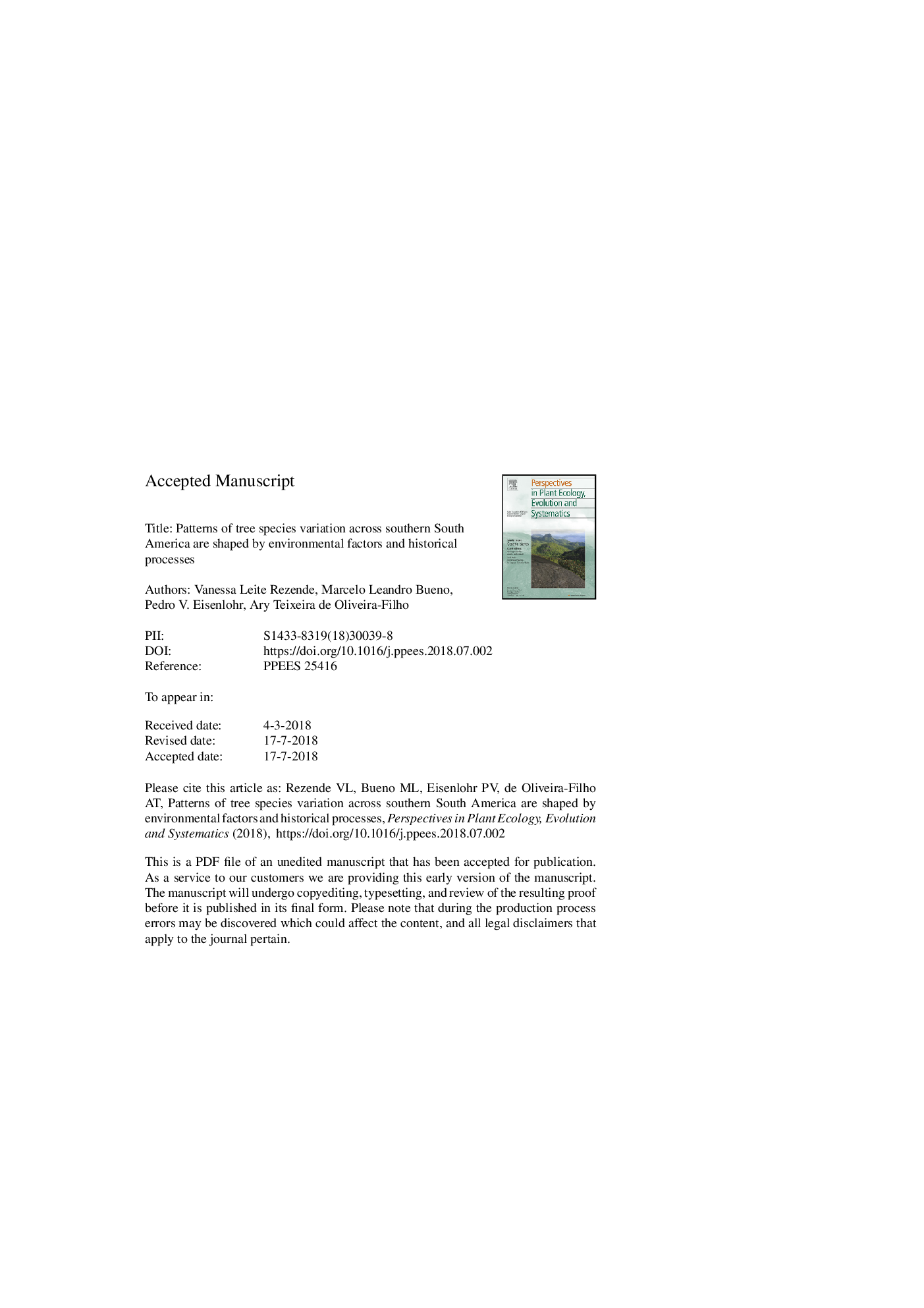| کد مقاله | کد نشریه | سال انتشار | مقاله انگلیسی | نسخه تمام متن |
|---|---|---|---|---|
| 8849470 | 1618586 | 2018 | 29 صفحه PDF | دانلود رایگان |
عنوان انگلیسی مقاله ISI
Patterns of tree species variation across southern South America are shaped by environmental factors and historical processes
ترجمه فارسی عنوان
الگوهای تنوع گونه های درختی در جنوب آمریکای جنوبی به وسیله عوامل محیطی و فرایندهای تاریخی شکل می گیرد
دانلود مقاله + سفارش ترجمه
دانلود مقاله ISI انگلیسی
رایگان برای ایرانیان
کلمات کلیدی
ترجمه چکیده
بخش جنوبی آمریکای جنوبی که شامل تنوع زیاد و منحصر بفردی است، مناسب برای مطالعاتی است که به تعامل بین زیست شناسی و شرایط محیطی محلی مربوط می شود و این که چگونه این فرآیند تاریخی و متغیرهای محیطی بر الگوهای توزیع اثر می گذارند. ما در اینجا نقش متغیرهای محیطی و فرآیندهای مستقل اتفاقی در الگوهای رانندگی گونه های درختی در کل جنگل های جنوبی آمریکای جنوبی را بررسی کردیم. ما یک مجموعه داده ای حاوی 110،087 سوابق وقوع 3183 گونه را که در 742 سایت در شش کشور و 13 بیوم توزیع شده است، گردآوری کردیم. ما تاثیر متغیرهای محیطی و فضایی مربوط به محدودیت های توزیع جغرافیایی بر تغییرات ترکیب گونه ها را با تجزیه و تحلیل جزئی کانون های اضافی مدل سازی کردیم. ما این مدل ها را برای هر یک از چهار مجموعه داده هایمان ساخته ایم: کل ناحیه غارنوردی آمریکای جنوبی؛ اقیانوس اطلس و پامامای بیوم؛ خشک جوامع در شرق آند؛ و جوامع در غرب آند. هر دو متغیر فضایی و محیطی بر ترکیب گونه های درختی در منطقه جنوب آمریکای جنوبی تأثیر می گذارند، هرچند نقش مهمی در آن نقش دارد. کسر فضایی این بزرگترین اهمیت ساختارهای فضایی، اهمیت فرایند تاریخی برای این منطقه را تقویت می کند و از هم گسیختگی فلوریستی بین بخش های گرمسیری و غارنشین آمریکای جنوبی برقرار می کند. ما استدلال می کنیم که جنگل های جنوب آمریکای جنوبی (به ویژه بخش های معتدل آن) نباید درون استان گلبرگ نئوتروپیک قرار گیرد، ایده بسیار مهم برای حفاظت از این جنگل های باستانی تنوع بسیار زیاد.
موضوعات مرتبط
علوم زیستی و بیوفناوری
علوم کشاورزی و بیولوژیک
بوم شناسی، تکامل، رفتار و سامانه شناسی
چکیده انگلیسی
The southern portion of South America, which encompasses high and exceptional lineage diversity, is well-suited to studies addressing the interaction between biogeography and local environmental conditions and how this historical process and environmental variables affect distribution patterns. We here assessed the role of environmental variables and spatially autocorrelated processes in driving tree species distribution patterns in the whole southern South America forests. We compiled a dataset containing 110,087 occurrence records of 3183 species distributed into 742 sites across six countries and 13 biomes. We modeled the influence of both environmental and spatial variables related to geographic distribution limitations on the variations of species composition through partial canonical redundancy analysis. We built such models for each of our four datasets: the whole extratropical area of South America; Atlantic and Pampa Biomes; dry communities east of the Andes; and communities west of the Andes. Both spatial and environmental variables affect tree species composition in the southern region of South America, although a major role is played by the “pure” spatial fraction. This greatest significance of spatial structures reinforces the importance of historical process for this region and the floristic dissociation existing between the tropical and extratropical portion of South America. We argue that the southern South American forests (especially their temperate portion) should not be lumped into the Neotropical Floristic Province, an idea of utmost importance for the conservation of these high-diversity austral forests.
ناشر
Database: Elsevier - ScienceDirect (ساینس دایرکت)
Journal: Perspectives in Plant Ecology, Evolution and Systematics - Volume 34, October 2018, Pages 10-16
Journal: Perspectives in Plant Ecology, Evolution and Systematics - Volume 34, October 2018, Pages 10-16
نویسندگان
Vanessa Leite Rezende, Marcelo Leandro Bueno, Pedro V. Eisenlohr, Ary Teixeira Oliveira-Filho,
